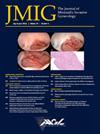接受过研究员培训的微创外科医生与普通妇科医生进行子宫肌瘤切除术的结果比较
IF 3.3
2区 医学
Q1 OBSTETRICS & GYNECOLOGY
引用次数: 0
摘要
研究目的比较由微创妇科手术(MIGS)亚专科医生与普通妇产科医生(OB/GYN)进行腹腔镜/机器人或腹部子宫肌瘤切除术的患者的手术效果。测量和主要结果主要结果是术中和/或术后并发症(复合)发生率。多变量回归分析包括在单变量分析中达到统计学显著差异且与临床相关的因素。在610例子宫肌瘤切除术中,460例(75.4%)为腹腔镜/机器人手术,其中401例(87.2%)由MIGS外科医生实施。460例(75.4%)为腹腔镜/机器人手术,其中401例(87.2%)由MIGS外科医生实施;150例(24.6%)为腹腔镜手术,其中37例(24.7%)由MIGS外科医生实施。MIGS外科医生的综合并发症发生率(11.0%)明显低于普通妇产科医生(26.2%,调整赔率比[aOR]2.57,95%置信区间[CI]1.39-4.72)。与普通妇产科医生(10.2%,p<0.001)相比,MIGS 外科医生转为开腹手术的比例较低(0.2%)。失血过多和/或需要输血(4.1% vs. 17.4%,aOR 3.61 95% CI 1.45-8.96)以及手术时间>第90百分位数(aOR 1.86,95% CI 1.01-3.42)在MIGS外科医生中较少见。在腹腔镜/机器人子宫肌瘤剔除术的子分析中,MIGS外科医生的综合并发症发生率(9.5% vs. 25.4%,p=0.001)、失血过多和/或输血需求(2.7% vs. 10.2%,aOR 5.75 95% CI 1.85-17.89)和手术时间(aOR 4.66,95% CI 2.22-9.78)均低于普通妇产科医生。仅在腹部肌瘤剔除术的子分析中,尽管MIGS组与普通妇产科外科医生每例手术切除的肌瘤数量明显较多(中位数21.0 vs. 6.0,p<0.001),但MIGS组与普通妇产科外科医生的综合并发症发生率相当。001)。结论接受过奖学金培训的 MIGS 亚专科医生与普通妇产科医生相比,子宫肌瘤切除术的手术效果更好,术中和/或术后并发症发生率更低,转为开腹手术的情况更少,失血量更少。本文章由计算机程序翻译,如有差异,请以英文原文为准。
Outcomes of Myomectomies Performed by Fellowship-Trained Minimally Invasive Surgeons Compared to General Gynecologists
Study Objective
To compare surgical outcomes among patients undergoing laparoscopic/robotic or abdominal myomectomy with minimally invasive gynecologic surgery (MIGS) subspecialists versus general obstetrician/gynecologists (OB/GYN).
Design
Retrospective cohort study.
Setting
Quaternary care academic hospital.
Patients or Participants
Patients undergoing myomectomy from 3/2015 to 3/2020 were included. Exclusion criterion was non-elective surgery.
Interventions
Myomectomy.
Measurements and Main Results
The primary outcome was the rate of intraoperative and/or postoperative complications (composite). Multivariable regression analysis included factors that reached statistically significant difference in the univariate analysis and are clinically relevant.
Of 610 myomectomies, 460 (75.4%) were laparoscopic/robotic, of which 401 (87.2%) were performed by MIGS surgeons. 150 (24.6%) were abdominal, of which 37 (24.7%) were performed by MIGS surgeons.
Composite complication rates were significantly lower for MIGS surgeons (11.0%) than for general OB/GYNs (26.2%, adjusted odds ratio [aOR] 2.57, 95% confidence interval [CI] 1.39-4.72). Rates of conversion to laparotomy were lower among MIGS surgeons (0.2%) compared to general OB/GYNs (10.2%, p<0.001). Excessive blood loss and/or need for blood transfusion (4.1% vs. 17.4%, aOR 3.61 95% CI 1.45-8.96) and surgery time >90th percentile (aOR 1.86, 95% CI 1.01-3.42) were less common among MIGS surgeons.
In a sub-analysis of laparoscopic/robotic myomectomies only, composite complication rates (9.5% vs. 25.4%, p=0.001), excessive blood loss and/or need for blood transfusion (2.7% vs. 10.2%, aOR 5.75 95% CI 1.85-17.89) and surgery time >90th percentile (aOR 4.66, 95% CI 2.22-9.78) were lower for MIGS surgeons compared with general OB/GYNs.
In a sub-analysis of abdominal myomectomies only, composite complication rates were comparable between MIGS and general OB/GYNs surgeons, despite a significantly higher number of fibroids excised per case in the MIGS group (median 21.0 vs. 6.0, p<0.001).
Conclusion
Fellowship trained MIGS subspecialists had better surgical outcomes for myomectomy compared with general OB/GYNs, with lower rates of intraoperative and/or postoperative complications, fewer conversions to laparotomy, and less blood loss.
求助全文
通过发布文献求助,成功后即可免费获取论文全文。
去求助
来源期刊
CiteScore
5.00
自引率
7.30%
发文量
272
审稿时长
37 days
期刊介绍:
The Journal of Minimally Invasive Gynecology, formerly titled The Journal of the American Association of Gynecologic Laparoscopists, is an international clinical forum for the exchange and dissemination of ideas, findings and techniques relevant to gynecologic endoscopy and other minimally invasive procedures. The Journal, which presents research, clinical opinions and case reports from the brightest minds in gynecologic surgery, is an authoritative source informing practicing physicians of the latest, cutting-edge developments occurring in this emerging field.

 求助内容:
求助内容: 应助结果提醒方式:
应助结果提醒方式:


